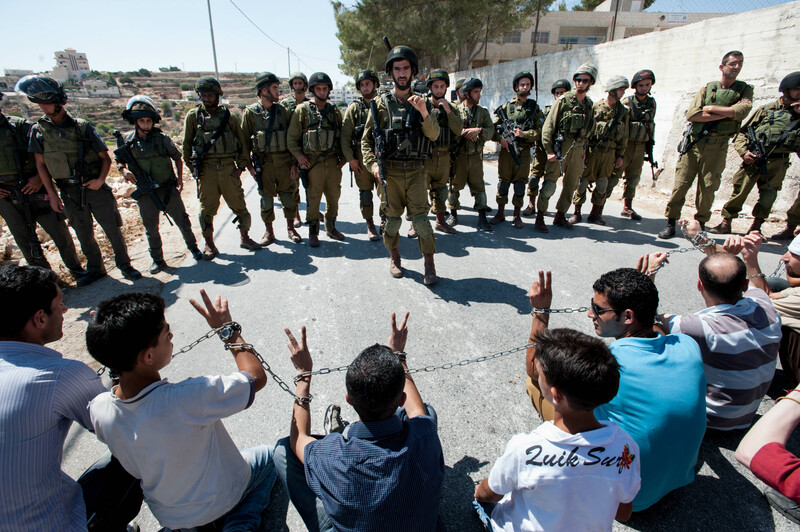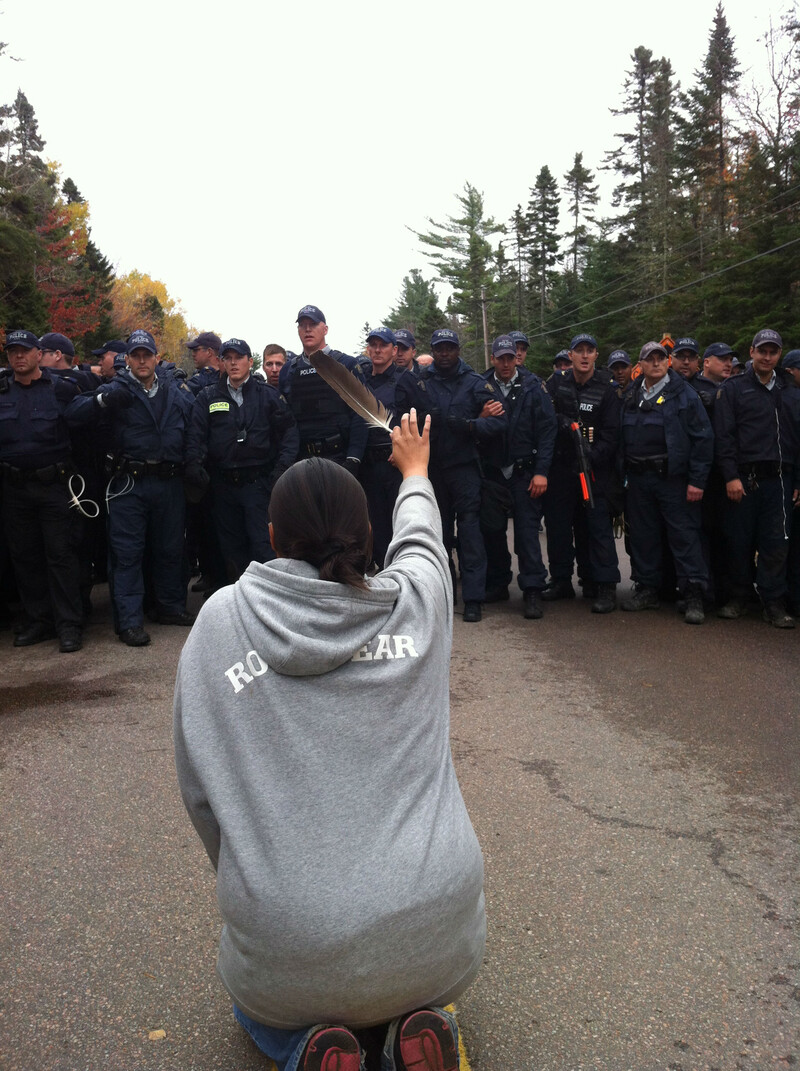The Electronic Intifada San Francisco 3 June 2014

A woman protests as South African soldiers occupy Soweto, July 1985. (Paul Weinberg / University of Cape Town Libraries)
On 22 March 1960, The New York Times published an editorial that ran next to a report from Johannesburg about how the South African police had opened fire on a massive group of protesters against the apartheid policy requiring black citizens to carry passbooks at all times.
The Times wrote a brief and unequivocal response: “The evil policy of apartheid … cannot help bearing evil fruits … The fact remains that a policy which degrades the great majority of the people of a nation is certain to lead to tragedy … The African men and women were armed — those who were armed — with stones … It was easy to kill some fifty men and women and to wound scores more.”
The death toll of this horrifying event eventually rose to 69, with nearly two hundred more injuries, and the now infamous event — the Sharpeville massacre — is considered a key turning point in the South African resistance movement.
The evil of apartheid, exemplified by the Sharpeville massacre, was recognized and articulated by The New York Times’ editorial regarding South Africa’s regime.
This clarity is starkly absent from its reporting on or discussions of Israel and Palestine.
For example, very recently, the Times attempted to hold Palestinian teenagers Nadim Nuwara and Muhammad Abu al-Thahir responsible for being shot and killed by Israeli soldiers during a Nakba Day protest on 15 May (“Video renews questions on death of young Palestinians”).
Instructive
Juxtaposing the violence wrought on Palestinians and those less-debated regimes of violence is instructive.
In Victoria, British Columbia — also on 15 May — the Canadians for Peace and Justice in the Middle East (CJPME) Foundation premiered its photographic exhibition, Dispossessed, but Defiant: Indigenous Struggles from Around the World, which displayed rare archival photos from apartheid South Africa, the First Nations of Canada and Palestine.
Thomas Woodley, the president of CJPME, told The Electronic Intifada that the exhibition was not designed to explicitly draw parallels among the regions’ experiences of dispossession and colonization. “We didn’t set out and say, ‘let’s have an exhibition of parallels,’ but a casual observer can’t help but see similarities between certain photos,” he explained.
Work on the exhibition began about eight months ago. “It was tricky to find photos,” Woodley said. “We wanted to go beyond what you will find on the Internet.”
CJPME enlisted the help of experts from each region to ensure accuracy: Dr. Marie Battiste at the University of Saskatchewan advised on the presentation of the indigenous people, and John S. Saul, a retired professor at York University, provided guidance on apartheid South Africa.
For Palestine, the group consulted James Reilly, an historian of the modern Middle East at the University of Toronto. Reilly told The Electronic Intifada, “I think it is potentially effective to compare Palestinians’ experiences with those of indigenous peoples in other countries (including our own) who are or who have been deprived of their universally acknowledged rights by settler-colonialism.”
Reilly added: “But the exhibit may be ineffective for audiences who are not disposed to think of settler colonialism as an appropriate framework for understanding the histories of South Africa and North America, not to speak of Palestine. That would require a broader educational effort beyond the scope of an exhibit like this one.”
“Demystifying” Palestine
The exhibition begins with photographs from the end of the nineteenth century: a Palestinian fisherman in Yafa (Jaffa in present-day Israel), men cutting soap and women painting pottery in the city of Nablus, and families harvesting their olive groves. It moves on to Britain’s occupation and suppression of Palestinian resistance, and then to 1948, with images of Palestinian families loading their belongings onto their backs and fleeing from Zionist militias by land and sea.
Reilly said, “I hope the exhibit will raise people’s consciousness and will help to demystify the Palestine question by pointing out its origins in modern history — not in ‘ancient hatreds.’”
These historical photos of Palestine are mainly derived from the collections of Palestinian poet and historian Elias Sanbar, historian Walid Khalidi, and the Institute for Palestine Studies. Contemporary photos of Palestine were provided by ActiveStills, a group of local and international photographers.

Palestinians demonstrate against Israel’s wall near al-Masara village in the occupied West Bank, September 2012.
ActiveStillsSouth African photos were mined from the Robben Island Museum archives, the Museum of Africa and the National Library of South Africa.
Procuring rights to photos of the First Nations of Canada proved to most difficult for several reasons. Much of the decimation of the First Nations had already occurred by the time photography became commonplace. An arguably more important factor was that many of the most illustrative photos remain the property of churches, which colluded with the Canadian federal government to remove aboriginal children from their families and place them in housing far away, where they would then be raised as Christians and indoctrinated into the Euro-Canadian way of life, exploited for household labor and subjected to harsh abuse.
In many cases, churches would not grant CJPME permission to use the most poignant or revelatory archived photos because, according to Woodley, they were “reluctant to admit the role they played.” He noted that the Presbyterian church was the marked exception and did share photos.
Woodley described one particularly haunting picture from one hundred years ago, which showed several aboriginal children praying around a three-foot statue of the Virgin Mary. “But the church that owned this picture didn’t want us to use it,” he said.
“Immediacy”

Elsipotog First Nations woman during Canadian police raid on Mi’kmaw-led anti-fracking blockade, October 2013.
APTN“Photographs have an immediacy that the written text alone does not convey,” Reilly said.
The compelling power of photographs is perhaps the reason the display sparked an attempt to shut it down.
Five hours before the opening ceremony, the Community Arts Council of Greater Victoria (CACGV), an arts organization hosting the exhibition, received anonymous threats of violence and vandalism along with demands to remove the photos.
The Electronic Intifada reached out for comment to Harry Abrams, a representative of the Zionist organization B’nai Brith in Canada, and an outspoken critic of the exhibition. Abrams replied, “Go somewhere else.”
Abrams did tell Times Colonist, a daily newspaper in Western Canada, that he opposed the exhibition because “It’s not even-handed.”
The Times Colonist wrote that Abrams believed “the exhibition is problematic for the way it represents Israelis as colonizers, rather than people indigenous to the area returning to their land” (“Controversial Cedar Hill show will continue,” 16 May 2014).
In 2007, Abrams filed a complaint with the Canadian Human Rights Commission against a website for publishing articles that question Israel’s right to exist as a Jewish state, describing them as promoting hatred of Jews and/or citizens of Israel. Among the articles in question included the work of journalist Chris Hedges and political scientist Virginia Tilley.
Daunted by the severity of the threats, Bob Williams, the president of Community Arts Council of Greater Victoria, came close to shutting down the exhibit but CJPME convinced him to keep it up per their contractual obligation.
The exhibition remained at the Community Arts Council of Greater Victoria until 30 May and is now moving to Ontario. CJPME plans to take the exhibit throughout Canada and the US over the next two years.
Woodley hopes that as the exhibit tours, the conversation will focus on the content of the photographs, rather than the controversy they stir. “Whenever anyone does anything artistic for Palestinian human rights in the West, the pro-Israel groups inevitably issue a number of negative reviews that eventually create a ‘wave’ of negative publicity and create questions of legitimacy around the whole thing,” he said.
“I am a believer in the common sense of the average person, if given the opportunity to explore something for themselves.”
Charlotte Silver is a journalist based in San Francisco. Follow her on Twitter: @CharESilver.




